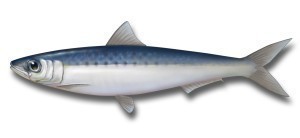Dimensions of a Sardine
The size of the sardines can be difficult to determine  because there are many species that can be placed under the name. As a general rule, length can vary from 6 cm to 22 cm long and the weight maxing out at 183 g. However, problems defining size arises because the definition is sometimes unclear.
because there are many species that can be placed under the name. As a general rule, length can vary from 6 cm to 22 cm long and the weight maxing out at 183 g. However, problems defining size arises because the definition is sometimes unclear.
Sardines and Pilchards
Traditionally, the sardine and the pilchard refer to the same kind of species; small oily fish that are related to the herring. However there are some researchers that make a distinction between the two. Some studies name six species pilchard, with over a dozen fish affixed with the sardine name.
Other databases have even more fish species called sardines. Some researchers have suggested that fish less than 6 inches (15 cm) long be called sardines; any fish longer should be termed pilchards.
Adding to the confusion about the size of the sardines is that some countries classify their young as pilchards. It should also be stated that canned fish sold as sardines are often herrings or sprats.
Origin
The name is derived from the island of Sardinia in the Mediterranean where the sardines used to proliferate.
The Rainbow Sardines
Be that as it may, there is agreement about the classification of several types of sardines. In the genus Dussumeria are two species: the Rainbow sardine (Dussumieria acuta) and the slender rainbow sardine (Dussumieria elopsoides).
The rainbow sardine has a shiny blue color with golden lines underneath it. This color dissipates quickly when the fish dies. Regardless of the size of the sardines in this species, the hind margin always has a dark color.
The rainbow sardine has numerous anal fin rays and pelvic scute shaped like a W. This species is found along the Persian Gulf and also in the Philippines, Indonesia, Malaysia, India and Pakistan.
The Slender Rainbow Sardines
The slender rainbow sardines can be found in the South China Sea and Indian Ocean. The fish is also known as Dussumieria productissima and Dussumieria hasselti. This fish belongs to the Clupeidae family.
From its discovery in 1849 to the 1980s, the fish was often mistaken for the rainbow sardine. The major difference is that slender rainbow sardines don’t have sriae at their scales’ posterior. Some scientists also believe that the slender rainbow sardine has more vertebras.
The slender rainbow fish are at least 8 cm long and can reach 18 cm. their sides are silver in color. This turns into a blue on the fish’s back. The underside is white. As the name suggests, the fish comes with an extended body.
The nose is pointed and the belly has a round shape. There is one dorsal fin slightly behind the center point. It has a heavily forked tail. This tail can be removed. The slender rainbow sardine has no scales at its head and no lateral line.
Whatever the difference of opinion about the size of the sardines may be, there is no question that it remains a popular food in many parts of the world, including Portugal, India, France, the Balkans and Morocco and Spain.





